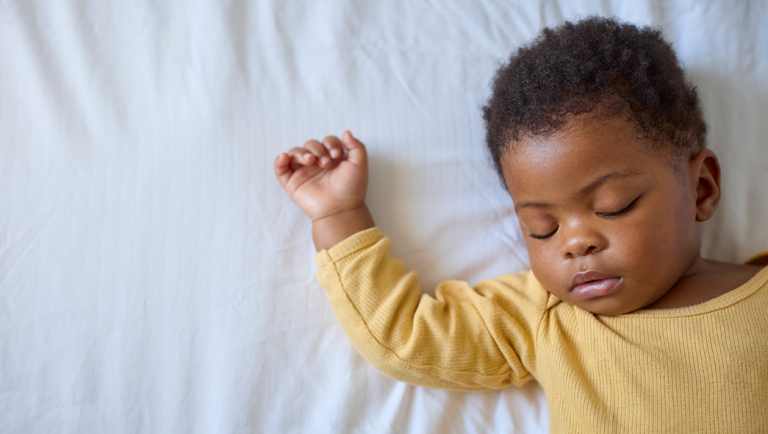As a new parent, you want to do everything right for your baby — including helping them sleep safely. But with so many products online and trending on social media, it’s hard to know what’s truly safe.
“Some products may look cozy or promise better sleep, but they may increase the risk of suffocation or sudden infant death syndrome (SIDS),” says Neonatal Intensive Care Educator Stefanie Clarke, BSN, CCRN. “Even popular or trendy items can be unsafe for sleep.”
Let’s talk about what’s safe for your baby — and what’s not.
What Safe Sleep Looks Like
The American Academy of Pediatrics (AAP) recommends following the ABCs of safe sleep:
- Alone
- Back
- Crib
Your baby should always sleep alone, on their back, and in a crib or bassinet with a firm, flat surface. No pillows, blankets or toys — just a fitted sheet and your baby.
“This is the best sleep setup for a newborn, backed by years of research and safety guidelines,” says Clarke.
Products That Are Not Safe for Sleep
Knowing what not to use in a crib is just as important as knowing what to include. These products may look helpful or be recommended by influencers, but they’re not safe for sleep, even for naps.
1. Inclined Sleepers
These cushioned loungers or rockers can cause babies to roll into unsafe positions.
Not safe: Rock ‘n Play, baby loungers or anything with an incline over 10 degrees.
Why: The angle can block a baby’s airway and lead to suffocation.
2. Docking Stations or Baby Nests
These are made for lounging while awake but are often misused for sleep.
Not safe: DockATot, Snuggle Me Organic or similar products.
Why: Soft sides can block breathing if your baby rolls.
3. Pillows, Bumper Pads or Loose Blankets
Even though they may seem cozy, these soft items can be deadly.
Not safe: Crib bumpers, stuffed animals, head-shaping pillows or blankets.
Why: Babies can press their face into them and suffocate.
4. Smart Socks and Monitors
These wearable devices may seem like peace of mind, but they aren’t regulated medical devices.
Not safe: Smart socks, wearable monitors or movement trackers.
Why: They can give a false sense of security and don’t prevent SIDS.
5. Products Designed to Prevent Reflux or Colic
Inclined products marketed to reduce reflux, gas or colic can be dangerous during sleep.
Not safe: Wedges, inclined sleepers or anything propped for reflux relief.
Why: Babies can slide into positions that block their breathing.
6. Items with “90-Night Trials” or Return Guarantees
Sleep products with long trial offers often focus on comfort, not safety.
Not safe: Soft-surfaced loungers or nests advertised for better sleep.
Why: If it’s not firm, flat and approved for sleep, it’s not safe — no matter the guarantee.
7. Stuffed Animals and Plush Toys
Even cute soft, cuddly toys are dangerous in a crib.
Not safe: Stuffed animals, plush toys or loveys in the crib.
Why: These can block your baby’s airway if they roll.
But It’s Sold in Stores — Isn’t That Safe?
Not always. Just because a product is for sale doesn’t mean it meets safety standards. “If you’re unsure, always check with your child’s pediatrician,” says Clarke. “Or visit our safe sleep page to find trusted information.”
Safe Sleep Can Be Simple
The good news? You don’t need fancy or expensive gear. A safe setup includes:
- A crib, bassinet or play yard approved for sleep.
- A firm, flat mattress.
- A fitted sheet.
- Your baby, dressed in a sleep sack or wearable blanket.
That’s all you need for peace of mind.
For recent recalls and reports on unsafe baby products, visit SaferProducts.gov to stay informed.
Support You Can Count On
Being a parent can feel overwhelming, but you don’t have to figure it out alone. We support you through every stage — including the “fourth trimester,” the critical first three months after birth.
Our Beyond Delivery virtual support group covers safe sleep feeding, postpartum wellness and more. “It’s a safe place to ask questions and connect with other new parents,” says Clarke.
Knowing what not to use in a crib and being aware of unsafe sleep products helps keep your baby safe during every nap and overnight stretch.
Visit our Safe Sleep page for tips on what works and what to skip or download our helpful infographic below to have on hand at all times. When in doubt, talk to your pediatrician—whether at St. Elizabeth or another trusted local provider—about what’s best for your baby.

Medically Reviewed by Stefanie Clarke, BSN, CCRN.

